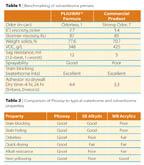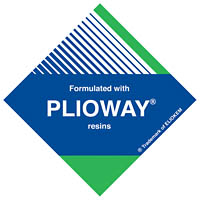New Resins for Formulating Interior, Odorless, Solventborne, Stain-Blocking Primers

In the United States, solventborne products still represent approximately 25% of the total market volume for interior stain-blocking primers. Why is that, when many national, regional or local legislations and initiatives concerning VOCs have been put in place in the last few years? The contractors have the answers. They know that in some specific cases, the performance of solventborne stain-blocking primers is much better than waterborne at covering heavy stains (e.g., watermarks, nicotine, markers, smoke), while providing superior adhesion over problematic surfaces, giving better film leveling and durability. These are some of the unique advantages of the solventborne stain-blocking primers over their waterborne counterparts, and this will be the focus of this article. To help the paint chemist formulate a solventborne coating without sacrificing quality, Eliokem has developed new resins that can be dissolved in ‘odorless' solvents. Eliokem also has available a team of coating formulators that will help with customer coating requirements.

Since their introduction to the U.S. market in 1997, odorless stain-blocking primers have gained a well-deserved reputation. They are appreciated for their unique combination of highly effective stain blocking, traditionally associated with solventborne products, as well as with the comfort of application and low odor commonly associated with waterborne products. A good primer has to be compatible with a wide variety of substrates that may be encountered in an interior situation, such as drywall, cement, concrete, plaster and spackling, wood, paneling, old paint, metals, fiberboard, etc. Very frequently, particularly in renovation work, the surfaces encountered will be covered with a variety of stains, such as water-soluble types from water leaks, smoke, nicotine, inks, etc., as well as solvent-soluble stains such as tar, tannin and others.
Some states are in the process of introducing stricter legislation where the VOC limit is set to decrease to 350 g/L from the current 450 g/L limit for the specialty primers, sealers and undercoats category. This poses a tough challenge to manufacturers and resin suppliers. In order to decrease the coating VOC, it is necessary to remove solvent from the formulation. This has the effect of increasing relative solids content (both pigment + binder) in the formulation, which has a negative effect on viscosity. Increasing resin content primarily increases high-shear viscosity, and that is important for sprayability. Increasing pigment content primarily affects low- and medium-shear viscosities, which are important for flow, leveling and sag resistance. When formulating a low-odor, low-VOC primer, if the plan is to increase the binder, then resins with lower viscosity profiles and solubility in low-odor, isoparaffinic solvents are needed. Plioway® Ultra 350 has been developed to have a reduced viscosity profile and excellent solubility characteristics in isoparaffinic solvent. Plioway Ultra G-20 is a rheological resin that promotes adhesion and helps prevent settling.
The Ultra 350 and Ultra G-20 were used in combination with Isopar® G. Isopar G, in addition to being lower in odor than solvents typically used in solventborne systems, also has a higher margin of safety versus stronger solvents. The following discussion on Air Change Index (ACI) illustrates that less air turnover is needed when using Isopar G in comparison to other solventborne systems such as alkyds.

All solvents should be handled with care, and even though there is some hazard associated with all solvents, the level of hazard can vary widely based on solvent selection and application conditions. However, the question still remains, "How can you tell which solvents are less hazardous?"
The indoor use of solventborne primer results in increased solvent exposure due to build-up of fumes in the air. One way to reduce the amount of solvent in the air is to use fans to renew the air. The ACI of a solvent is an indication of the margin of safety of a solvent. The lower the ACI, the less air turnover needed.
The ACI is calculated based on the amount of solvent in the primer, the volume of the room to be primed, the volatility of the solvent and the amount of primer to be applied. Figure 1 shows the ACI for paints formulated with different solvents. The calculations were made based on a 3500 ft3 room and primer with coverage of 375 ft2/gallon. The calculated ACIs were done on solventborne primer containing 350 g/L of solvents and the waterborne primer containing 50 g/L of butyl glycol.
The values on this chart indicate that the use of mineral spirits-based primers would need six to seven air changes per hour, requiring significant ventilation. The use of Isopar G-based primers would only need one to two air changes per hour. Finally, the use of waterborne primers would need less than one air change per hour. Another way to interpret this information is that the margin of safety is three to four times higher with Isopar G than with mineral spirits, and five to six times higher than with toluene. However, proper ventilation is still good practice with any type of primer.
The use of odorless stain-blocking primers with Plioway resins and Isopar G as the solvent provides the following benefits:
- the advantages of solventborne technology without the disadvantages of regular solvent in terms of health concerns;
- improved comfort of application since Isopar G solvent is odorless; and
- even less odor than with the waterborne stain-blocking primers.
Plioway Resins
When formulating odorless solventborne stain-blocking primers, excellent solubility in low-odor, isoparaffinic solvents is required. Eliokem recognized this and developed two resins that easily meet this need:
- Ultra 350 resin is a low-viscosity-profile Newtonian resin soluble in odorless isoparaffinic solvents. The resin is also soluble in a broad range of other solvents. Ultra 350 can be formulated for applications under 350 VOC.
- Ultra G-20 resin is a rheological film-forming resin soluble in odorless isoparaffinic solvents. When dissolved in de-aromatized or isoparaffinic solvents, this resin develops a gel that imparts outstanding rheological properties to finished coatings.
Features and Benefits
Adhesion and Tension-Free Film Formation
The fine particle size of the dissolved Plioway resins enables the wet primer to penetrate deep into the substrate. Primers based on these resins form tension-free films. Unlike alkyd primers, they do not crosslink (and, hence, shrink) during the film formation process. These characteristics give Plioway-based primers excellent long-term adhesion on difficult surfaces.
Odorless
The high solubility of Plioway resins allows primer formulation in aromatic-free, low-odor solvents. Primers have virtually no odor during application and drying. Traditional alkyd primers are formulated with more powerful solvents, and thus have a stronger odor. Moreover, they have a characteristic residual drying oil smell arising from the alkyd resins during the crosslinking reaction. This is not present in primers made with Plioway resins.
Universal Application
Primers based on Plioway resins are alkali resistant and can be directly applied on fresh plaster or cement. Alkalinity from such substrates would destroy alkyd-based primers because they are susceptible to reactions with the alkali.
Fast Dry
The film formation, by simple solvent evaporation, gives the formulator the ability to produce primers with fast drying rates (even faster with higher-solids, lower-VOC paints). Alkyd-based primers have longer drying times.
Sprayability
The molecular weight of the Plioway resin has been optimized to allow excellent spray during application. This system permits wider fan width and uniform spray without fingering.

Experimental
The following tests were performed on the primers:
- Odor (in-can, rated 1-8, 1 is best);
- Viscosity, ICI (ASTM D 4287);
- Viscosity, Stormer (ASTM D 562);
- Weight solids (ASTM D 2369);
- VOC was calculated from the measured weight per gallon and weight solids, using the formula: VOC (g/L) = (100 - wt. solids) X 10 X wpg / 8.34;
- Leneta sag resistance (ASTM D 4400);
- Sprayability (airless application using Graco Ultra 450, 0.75 gpm electric pump, 50 foot, 3/8 inch diameter hose, 517 tip, maximum pressure (approx. 3000 psi);
- Stain blocking (of waterborne marker inks), 10 mil wet drawdown;
- Adhesion to drywall (10 mil wet drawdown), after 4 hrs and 24 hrs drying (ASTM D 3359, X-cut + tape pull off test, rated 0-5, 5 is best).
The results in Table 1 illustrate that the Plioway-based formulation performed well, with a good overall balance of properties. The in-can odor for the Ultra 350 and Ultra G-20 formulation was for all practical purposes odorless, while the commercial product had a strong odor. The ICI and Stormer viscosities for this formulation were in ranges that permitted good sprayability while maintaining good sag resistance, whereas the commercial product exhibited poor sprayability with only moderate sag resistance. Finally, the Plioway-based product showed better adhesion to drywall.
Solventborne Versus Waterborne Primers
The question still remains as to why solventborne stain-blocking primers continue to represent a significant portion of this market. A simplified comparison of what contractors already know is given in Table 2. Essentially, it illustrates that the overall performance of solventborne stain-blocking primers is much better for blocking and covering heavy stains. Furthermore, the information contained in the table illustrates that the Plioway system combines the benefits of both the solventborne and waterborne systems.
The pictures in Figure 2 illustrate direct comparisons of a Plioway-based primer versus a commercial waterborne primer. The left-hand picture is of primers applied over drywall marked with waterborne inks and the picture to the right is of primers applied to cedar to block the tannin. Both illustrate the superior blocking ability of the Plioway-based primer.

A stain-blocking formulation has been developed that meets all of the following:
The study presented in this article shows that Plioway resins provide the solubility needed to formulate coatings that compare favorably with commercial products containing higher VOC levels. Furthermore, these resins have been specifically formulated to be soluble in odorless solvent systems, which is an important factor for indoor applications. Not only does odorless contribute to the ease of application for the contractor, it benefits facilities where the evacuation of the building would be impractical, such as hospitals, businesses, etc.
This resin technology is continuously being developed to bring new products and applications to the market and also to accommodate changes in market requirements such as those brought about by local or national legislation.
Eliokem is prepared to be a partner in meeting any future challenges in the coatings industry.

Plioway Logo Program
The Plioway Logo Program is a promotional initiative to support Plioway-based interior stain-blocking primers satisfying the highest level of performance. To this end, Eliokem has defined a ‘performance specification' based on many years of experience in formulating and testing primers. Only primers that pass will be allowed to use the trademark and/or display the logo.
For the paint manufacturer, the use of the trademark and/or logo offers the opportunity to benefit from all the promotional activity in which Eliokem participates. For the consumer, the logo will signify that the Plioway-based primer they have chosen conforms to certain performance requirements.
It is in this spirit that Eliokem invites primer manufacturers to participate in the Plioway Logo Program.
® Registered trademark of Eliokem
Looking for a reprint of this article?
From high-res PDFs to custom plaques, order your copy today!



